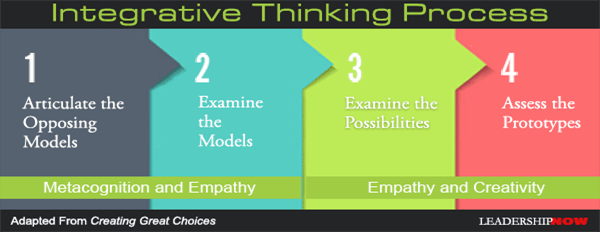Applying Integrative Thinking to Complex Social Issues
![]() Ms Ang Bee Lian, 23 May 2018
Ms Ang Bee Lian, 23 May 2018
Dear Social Service Practitioners,
Many of you would have realised in the course of your work that there are often few simple solutions to complex social issues. There is a Chinese quote 摸着石头过河 (mo zhe shi tou guo he), which translates to “crossing a river by feeling the stones”. As the quotes goes, when crossing a fast flowing river, every step is uncertain and there is a need to feel your way carefully to be sure of your footing before taking the next step. Similarly, in solving complex social issues we need to make on-going sensing about the environment with its dynamic interaction of factors and forces to ensure applicability and successful implementation of action plans. This person-in-environment concept is central to the social work perspective.
In addition, we need to be mindful of oversimplifying complex social issue in our zest to find innovative solutions. One example is the concept of the social impact bond. When this concept was first mooted, it represented the social sector’s first steps towards innovative problem solving. Under the social impact bond, the public sector or governing authority establish a contract with private investors whereby the former would pay for better social outcomes in certain areas and pass on the part of the savings achieved to investors.
However, over time, it was found that the social impact bond may not be achieving its intended objective. The Stanford Social Innovation Review recently published an interesting article called, The Downside of Social Impact Bonds. The article by Nadine Pequeneza, director of the documentary “The Invisible Heart” examines the challenges of viewing problems with too simplistic a lens and argued that social impact bonds might not be delivering as promised and might be doing more harm than good.
Simplistic Solutions to Complex Problems
While social impact bonds were mooted as a business model to solve social issues and promoted as a means to pre-empt costly services downstream by funding early interventions with private money, the business model when applied to its fullest extent resulted in the lack of comprehensive programme evaluation with reliance on sometimes singular intervention, factor or programme as outcome measures.
One main criticism by social service practitioners was that bond-linked programmes adopted a rather narrow perspective for helping families and has resulted in less comprehensive policy responses to unemployment, addiction and family violence. For example, a good intervention plan may require a holistic approach towards addressing the complex social issues faced by a family. However, as bond-linked programmes require direct attribution of outcomes to a particular programme, the focus may shift to a single programme instead of a whole suite of programmes to meet the needs of the family.
In addition, investors have been backing social programmes with a proven track record, that were already evaluated or where success was well documented. What happened then was that resources were diverted from less well funded but right-sited programmes to these bond-linked programmes because of their incentives. The need to return profits in a timely fashion to investors has deterred the kind of comprehensive programme evaluation that could lead to possible program improvement. These bonds were thus not structured with learning about possible programme improvement as a priority.
However, while social impact bonds have its limitations, the search for new ways to think and solve social issues (especially sticky ones), should continue. To do this, we need to adopt new mental models on the way we think about social problems.
Mental models
There are various proponents of how mental models affect our thinking or how thinking shapes our mental models. Recently, Roger Martin wrote about integrative thinking in his book, The Opposable Mind (2009). Martin identifies three components that are often lost in most decision-making processes: metacognition, empathy, and creativity.
Metacognition allows us to make better sense of our own thinking and existing mental models that shapes the choices we make. Empathy enables us to understand how others think, reveals our own logical gaps and how we might relate to others better. Creativity provides the imaginative spark to create new and better choices rather than just accept the options in the tension before us. Joined by Jennifer Riel in her book, Creating Great Choices (2017), the integrative thinking process comprising a four-step process was proposed as a way to change one’s mental model on solving complex social issues.
The Integrative Thinking Process

In applying the integrative thinking process, we started off with articulating the Models. This includes framing the problem, teasing out opposing models for solving it and identifying the core elements of each model. The aim is to create a two-sided dilemma for a general problem like using a centralized structure versus a decentralized structure or community participation versus expert opinion. Instead of choosing one model over the other, we want to take the best from each model.
We then move on to examining the Models, noting the tension between models, looking at the forces that drive the outcome or benefits that we most value and note the similarities and differences between the models. We look for assumptions that created the tension and determine the cause-and-effect forces and consider what benefit would we not want to give up from each of the models.
The next step is to create a new model by examining the Possibilities. There are three ways to do so through what Martin and Riel call the “hidden gem”, “the double-down” and “the decomposition”:
- The Hidden Gem requires us to tease out deeply valued benefit from each model, and discard the rest. The new alternative is then modelled around these gems picked up from each model. The discarded elements are then replaced with something new. For example, we will take one small element of A and B.
- The Double-Down requires us to identify the one model which we will choose if only it wasn’t missing on one critical element. So, we want A with a key element from B.
- In Decomposition, we want all of both models even when they appear contradictory. To do this, we have to reach a different understanding of the problem that we are trying to solve, break the problem down into different parts and apply each solution to the respective part.
Finally, we assess the Prototypes where we test out different solutions to find one that can be implemented to solve our problem.
How Integrative Thinking Can Help in Solving Problems
While integrative thinking may not be for every problem we face, it adds to the thinking tools for solving social problems which are often quite intractable and complex. As a tool, it helps to shift the conversation, defuses interpersonal conflicts and helps to move discussions forward. It helps discussants to understand other people’s views of the world and in turn inform and improve our own. It provides a way to work with opposing models to generate a new model that keeps the imperative of the opposing ideas.
References:
Pequeneza, N. (2019, May 31). The Downside of Social Impact Bonds. Retrieved from Stanford Social Innovation Review: https://ssir.org/articles/entry/the_downside_of_social_impact_bonds
Riel, J., & Martin, R. L. (2017). Creating Great Choices: A Leader's Guide to Integrative Thinking. Harvard Business Review Press.
Download the full letter here
 | MS ANG BEE LIANDirector of Social Welfare (1 Nov 2013 - 30 Jun 2020) |